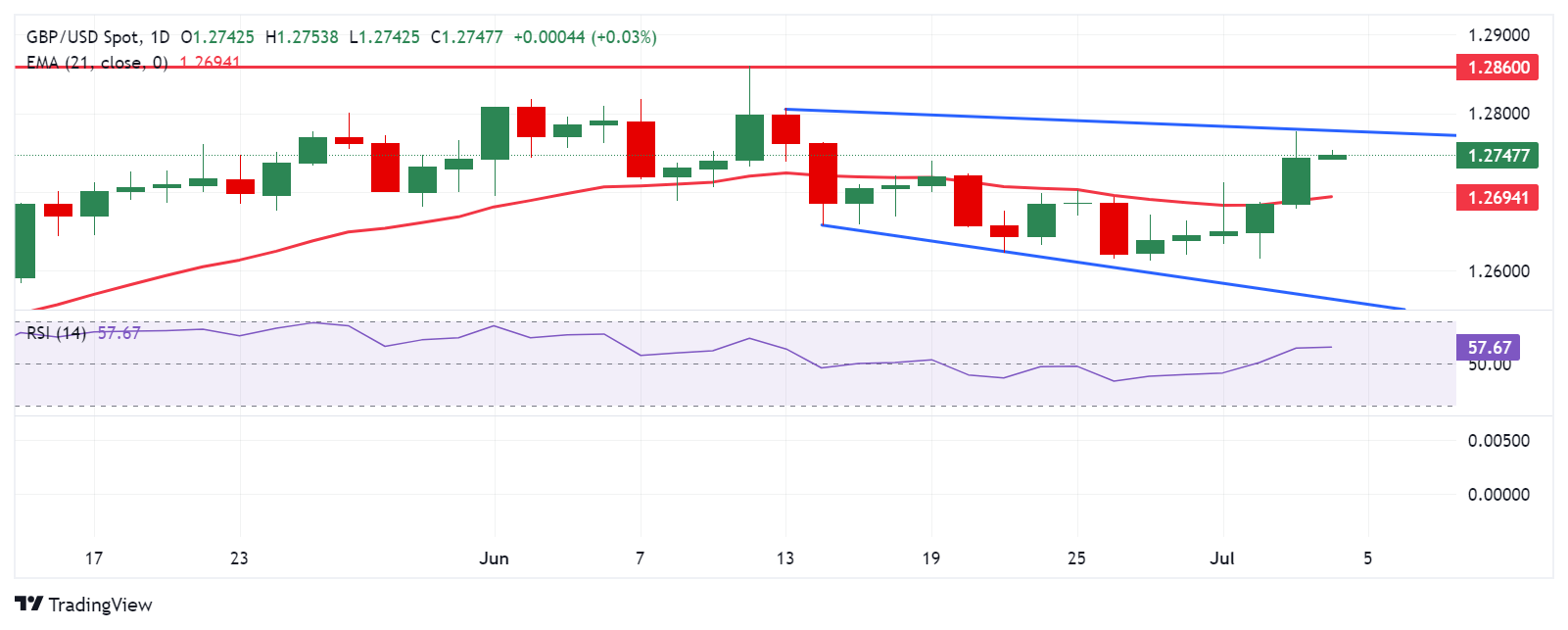Pound Sterling continues to extend gains amid the ongoing UK elections

- The Pound Sterling strengthens as US Dollar struggles after softer economic data.
- The Labour Party is expected to secure a record number of seats in the national election.
- The lower US Treasury yields contribute to the pressure on the US Dollar.
The Pound Sterling (GBP) continues its winning streak, which began on June 27. The GBP/USD pair trades around 1.2750 during the Asian session on Thursday, which could be attributed to the softer data released from the United States (US) on Wednesday.
Markets are expected to closely monitor the UK general elections on Thursday. Britain appears poised to elect Labour Party leader Keir Starmer as its next prime minister, ousting Rishi Sunak’s Conservatives after 14 often turbulent years. A forecast by polling company Survation, as reported by Reuters on Tuesday, predicts the Labour Party will win a record number of seats in the national election.
The US Dollar (USD) struggles due to the decline in the US Treasury yields, which could be attributed to the escalated speculations of the Federal Reserve (Fed) reducing interest rates in 2024. US markets will be closed on Thursday in observance of the Independence Day holiday.
Daily digest market movers: Pound Sterling extends gains amid UK elections
- Survation’s central scenario indicates that Keir Starmer’s Labour Party is projected to win 484 of the 650 seats in parliament, significantly surpassing the 418 seats won by former leader Tony Blair in his famous 1997 landslide victory, as per Reuters.
- US ISM Services PMI fell sharply to 48.8 in June, marking the steepest decline since April 2020. This figure was well below market expectations of 52.5, following a reading of 53.8 in May.
- The ADP Employment report showed that US private businesses added 150,000 workers to their payrolls in June, the lowest increase in five months. This figure fell short of the expected 160,000 and was below the downwardly revised 157,000 in May.
- Federal Reserve Bank of Chicago President Austan Goolsbee stated on BBC Radio on Wednesday that bringing inflation back to 2% will take time and that more economic data are needed. However, on Tuesday, Fed Chair Jerome Powell said that the central bank is getting back on the disinflationary path, per Reuters.
- The Minutes from the Federal Reserve’s June 11-12 monetary policy meeting, released on Wednesday, suggested that Fed officials were in a wait-and-see mode. “Some participants emphasized the Committee’s data-dependent approach, with monetary policy decisions being conditional on the evolution of the economy rather than being on a preset path.”
- The Pound Sterling (GBP) outperforms its peers as Bank of England (BoE) policymakers worry about stubborn inflation in the United Kingdom (UK) service sector, which has been refraining from leaning towards policy easing. Meanwhile, inflation in other sectors has declined significantly due to weak demand from domestic and overseas markets.
Technical Analysis: Pound Sterling hovers around 1.2750
The GBP/USD pair trades around 1.2750 on Thursday. The analysis of the daily chart shows a bearish bias as the pair consolidates within a descending channel. However, the 14-day Relative Strength Index (RSI) is above the 50 level, suggesting any decline going forward to be mild. Further movement may indicate a clearer directional trend.
The GBP/USD pair could test the upper boundary of the descending channel around the level of 1.2780. A breakthrough above this level could lead the pair to test June’s high of 1.2860.
On the downside, the key support appears at the 21-day Exponential Moving Average (EMA) at the 1.2694 level. A break below this level could exert pressure on the GBP/USD pair to navigate the area near the lower boundary of the descending channel around the level of 1.2570.
GBP/USD: Daily Chart
British Pound PRICE Today
The table below shows the percentage change of British Pound (GBP) against listed major currencies today. British Pound was the strongest against the US Dollar.
| USD | EUR | GBP | JPY | CAD | AUD | NZD | CHF | |
|---|---|---|---|---|---|---|---|---|
| USD | 0.00% | -0.04% | -0.19% | -0.02% | -0.15% | -0.10% | -0.11% | |
| EUR | -0.00% | -0.04% | -0.19% | -0.02% | -0.13% | -0.12% | -0.05% | |
| GBP | 0.04% | 0.04% | -0.14% | 0.02% | -0.09% | -0.09% | -0.04% | |
| JPY | 0.19% | 0.19% | 0.14% | 0.16% | 0.03% | 0.06% | 0.11% | |
| CAD | 0.02% | 0.02% | -0.02% | -0.16% | -0.12% | -0.08% | -0.06% | |
| AUD | 0.15% | 0.13% | 0.09% | -0.03% | 0.12% | 0.04% | 0.07% | |
| NZD | 0.10% | 0.12% | 0.09% | -0.06% | 0.08% | -0.04% | 0.03% | |
| CHF | 0.11% | 0.05% | 0.04% | -0.11% | 0.06% | -0.07% | -0.03% |
The heat map shows percentage changes of major currencies against each other. The base currency is picked from the left column, while the quote currency is picked from the top row. For example, if you pick the British Pound from the left column and move along the horizontal line to the US Dollar, the percentage change displayed in the box will represent GBP (base)/USD (quote).
Economic Indicator
Parliamentary Election
The U.K. Parliamentary Election released by the United Kingdom Parliament elects 650 members to the United Kingdom’s Lower House of Parliament. It is a significant event to determine the appropriate stance of monetary policy and assesses the risks to its long-run goals of price stability and sustainable economic growth in the u.K. The election might affect the GBP volatility.
